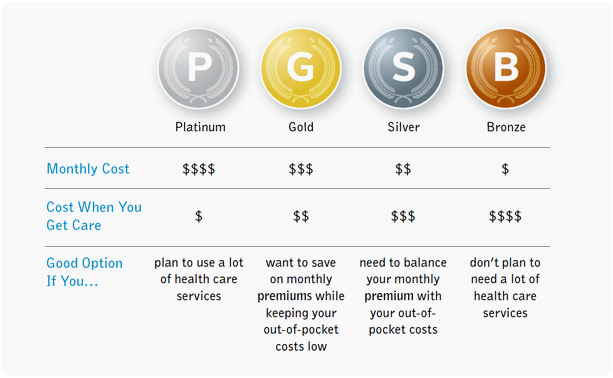How To Choose the Right Metal Level for Your Health Insurance Plan
By Hannah Ferris
Published March 5, 2014

Cost is usually a decisive factor for individuals and families shopping for a health insurance policy.
All of the plans offered on the Health Insurance Marketplace and through most of the carriers are qualified health plans (QHPs), meaning that they have been certified and contain the essential health benefits (EHBs) required by the Affordable Care Act (ACA).
The differences between the metal plans – Bronze, Silver, Gold, or Platinum – lie in the cost schemes of each. The category you choose affects how much your premium will cost each month and what part of the bill you will pay out-of-pocket for services like hospital visits or prescriptions.
Grouped By Actuarial Values
Metal plans are grouped based on actuarial values (AV), or the percentage of total costs covered by the insurance company.
For example, if you buy a “Silver” plan, the insurance company will pay 70% and you will pay 30% of the cost of a covered medical service. The following chart displays actuarial values for each of the four metal categories:
I shopped around on the Florida Blue website, to see what kinds of costs I would incur if I were to sign up for one of these plans as an individual. Florida Blue offers various plans at each metal level. Bronze plans tend to have higher deductibles and lower monthly premiums and Platinum plans have lower deductibles and higher monthly premiums.
According to the most recent federal statistics, Silver plans have been the most often purchased. 60% of those who purchased marketplace plans bought Silver metal plans, which provide many with a happy medium for premium and deductible rates. Florida Blue offers 10 Silver plans. Monthly premiums for me came in between $221 to $306 and deductibles from $2,100 to $5,000.
Things to Consider
There are several factors relating to your personal needs to consider when comparing the costs and benefits of metal plans. By using the shopping tools on the Florida Blue website, you can get help choosing a plan by inputting your preferences on the following:
- Which monthly premium amount would best fit your budget?
- Which deductible range would meet your needs? Remember this “general rule” – a higher deductible means a lower monthly premium and a lower deductible means a higher monthly premium.
- What percentage of co-insurance do you prefer to pay? Co-insurance follows the same general rule as deductibles – the higher the percentage of co-insurance paid at each doctor’s visit, the lower the monthly premium, and vice versa.
- What out-of-pocket maximum range would meet your needs? The out-of-pocket maximum also affects premiums and follows the same general rule as deductibles and co-insurance.
- If you would like to set up a health savings account (HSA).
- If you believe you will need access to out-of-network services.
- If you or your dependents will need vision and/or dental services.
Chart Source: Independence Blue Cross
Hannah Ferris was a past intern at the Bailey Group. Her interests in social policy and public health yield unique insights into health care reform. Ferris entered the MSc Social Policy and Development program at the London School of Economics in 2014. She loves traveling, fashion, and writing her own personal blog, "Hannah's Happenings."




